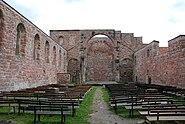
Former church of Vessra Abbey
Vessra Abbey (Kloster Veßra) was a Premonstratensian monastery in the village also named Kloster Veßra in the district of Hildburghausen, Thuringia, Germany.
The monastery was founded in the 1130s by Gotebold II, Count of Henneberg, and his wife Liutgard on a site near the confluence of the Schleuse and the Werra. The church was dedicated in 1138; the foundation received papal confirmation three years later.
For the whole of its existence of more than four hundred years the abbey was a family monastery of the Hennebergs. It also had a close association with the von Bibra family, particularly in the 1400's. During the Reformation in 1543, the monastery was turned into an estate.
The former monastery served another four hundred years as an agricultural estate, mostly in private hands, but after World War II as a possession of the East German state, and from 1953 as the site of a collective farm (Landwirtschaftliche Produktionsgenossenschaft, or LPG).
In 1975 the site was taken over by the Museum of the History of Agriculture of the DDR (Agrarhistorisches Museum der DDR). Since 1990 the site has been the home of the Hennebergische Museum, an open-air museum specialising in the display of re-located local buildings.
The abbey church, dedicated to Saint Mary, was used as the parish church for centuries until it burned down in the mid 20th century. The ruins are nevertheless substantial and after stabilisation it remains the most significant Romanesque building in the region. Of the monastic buildings themselves there remain the gate chapel and the accommodation block, with the ruins of the cloister.
Gallery
Sources
- (German) Hennebergisches Museum
- (German) Photo tour of the abbey
![Kloster Vessra 03.jpg (814 KB) Farmer's house from 1716 in the Henneberg Museum]]](https://upload.wikimedia.org/wikipedia/commons/thumb/a/a6/Kloster_Vessra_03.jpg/185px-Kloster_Vessra_03.jpg)




